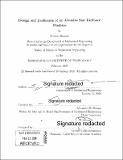| dc.contributor.advisor | Slocum, Alexander H. | |
| dc.contributor.author | Burcat, Steven,
author. | en_US |
| dc.contributor.other | Massachusetts Institute of Technology. Department of Mechanical Engineering. | en_US |
| dc.date.accessioned | 2023-04-07T16:54:32Z | |
| dc.date.available | 2023-04-07T16:54:32Z | |
| dc.date.copyright | 2020 | en_US |
| dc.date.issued | 2020 | en_US |
| dc.identifier.uri | https://hdl.handle.net/1721.1/150461 | |
| dc.description | Thesis: S.M., Massachusetts Institute of Technology, Department of Mechanical Engineering, 2020 | en_US |
| dc.description | Supervised by Alexander H. Slocum. Cataloged from the PDF version of thesis. | en_US |
| dc.description | Includes bibliographical references (page 65). | en_US |
| dc.description.abstract | Injuries from power saw kickback are often fatal. However, only woodcutting saws have regulations and assessment methodologies for kickback. These regulations do not apply to metal and masonry saws, as the cutting mechanism and dominant kick-back mode are different from those of woodcutting saws. In this work, the kickback of abrasive saws is investigated by combining theoretical and experimental tools. A theoretical model developed based on frictional engagement during a pinch-based kickback event is shown to predict the resultant kickback energy for various saws in good agreement with experimental measurements. These measurements were obtained using a specialized machine that was designed to generate pinch-based kickback and to measure the resultant kickback energy for both chainsaws and cutoff saws. While the model can predict the resultant kickback energy for a saw given known cutting conditions (i.e. cutting angle and pinch force), it does not predict the maximum possible kickback energy given any cutting angle of a saw because it does not account for the change in speed of the cutting blade. Upon validation of the physics model, two commonly used representative saws, a Stihl TS420 and an ICS 695XL, were tested using this kickback machine to evaluate their comparative kickback risk. This work demonstrates that pinch-based kickback can be a major safety risk for abrasive saw operators, and it provides a machine and analytical framework for evaluating this risk. | en_US |
| dc.description.statementofresponsibility | by Steven Burcat. | en_US |
| dc.format.extent | 65 pages | en_US |
| dc.language.iso | eng | en_US |
| dc.publisher | Massachusetts Institute of Technology | en_US |
| dc.rights | MIT theses may be protected by copyright. Please reuse MIT thesis content according to the MIT Libraries Permissions Policy, which is available through the URL provided. | en_US |
| dc.rights.uri | http://dspace.mit.edu/handle/1721.1/7582 | en_US |
| dc.subject | Mechanical Engineering. | en_US |
| dc.title | Design and evaluation of an abrasive saw kickback machine | en_US |
| dc.type | Academic theses. | en_US |
| dc.type | Academic theses. | en_US |
| dc.type | Thesis | en_US |
| dc.description.degree | S.M. | en_US |
| dc.contributor.department | Massachusetts Institute of Technology. Department of Mechanical Engineering | en_US |
| dc.identifier.oclc | 1373627925 | en_US |
| dc.description.collection | S.M. Massachusetts Institute of Technology, Department of Mechanical Engineering | en_US |
| dspace.imported | 2023-04-07T16:54:32Z | en_US |
| mit.thesis.degree | Master | en_US |
